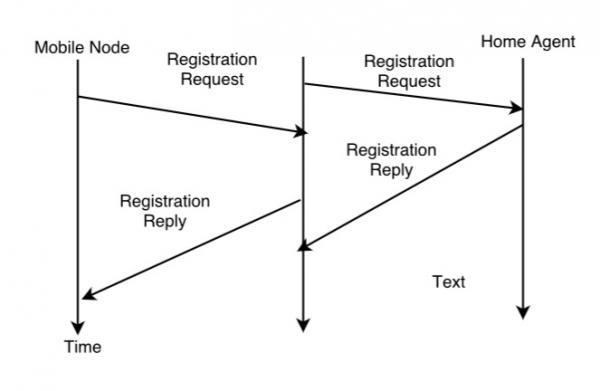
 Data Structure
Data Structure Networking
Networking RDBMS
RDBMS Operating System
Operating System Java
Java MS Excel
MS Excel iOS
iOS HTML
HTML CSS
CSS Android
Android Python
Python C Programming
C Programming C++
C++ C#
C# MongoDB
MongoDB MySQL
MySQL Javascript
Javascript PHP
PHP
- Selected Reading
- UPSC IAS Exams Notes
- Developer's Best Practices
- Questions and Answers
- Effective Resume Writing
- HR Interview Questions
- Computer Glossary
- Who is Who
Mobile ip a complete solution for emerging communications
The world is now embracing connectivity and communication like never before through the application of various mobility based devices. Mobile computing devices such as mobile phones, palmtops etc. have become a part of our daily routine as they are convenient and effective to use.
Mobile IP (Internet Protocol) serves the needs of the burgeoning population of mobile computer users who wish to connect to the Internet and maintain communications as they move from place to place.
Mobile IP (or MIP) is an Internet Engineering Task Force (IETF) standard communications protocol that is designed to allow mobile device users to move from one network to another while maintaining a permanent IP address.
It enables the transfer of information to and from mobile computers, such as laptops and wireless communications. The mobile computer can change its location to a foreign network and still access and communicate with and through the mobile computer’s home network.
Mobile IP for better Mobility
Mobile IP – A technology which supports mobile data and applications that are dealing with wireless connectivity. A user may now disconnect his computer in the office and reconnect from another site within the same office or elsewhere.

Mobile IP or IP-Mobility Management (IP-MM) is an open standard communication protocol defined by Internet Engineering Task Force (IETF) that allows mobile device users to move from one network to another without changing their IP address as a change in the IP address will interrupt ongoing TCP/IP communications. Mobile IP is an enhancement of the Internet Protocol (IP) which allows a node to change its point of attachment to the Internet without needing to change its IP address.
Mobile IP is independent of the physical layer technology as the mobility functions are performed at the network layer – any media that can support IP can support Mobile IP.
Components of a Mobile IP Network
Mobile IP has three major components as mentioned below –
Mobile Node − A device such as a cell phone, personal digital assistant, or laptop whose software enables network roaming capabilities.
The Home Agent − A router on the home network serving as the anchor point for communication with the mobile node; its tunnel packets from a device on the Internet, called a correspondent node, to the roaming mobile node.
The Foreign Agent − A router that may function as the point of attachment for the mobile node when it roams to a foreign network delivers packets from the home agent to the mobile node.
The Mobile IP process has three main phases –
Phase I − Agent Discovery
This is the phase where mobile node discovers its foreign and home agents. A mobile node first determines its connected location by using ICMP router discovery messages. If it’s connected location is with the local network, then the normal IP routing is used for the communication. When a mobile node determines that it has moved to a foreign network it obtains a care-of address from the foreign agent reflecting its current location.
Two types of “care-of” addresses exist –
The care-of addresses acquired from a Foreign Agent: An IP address of a Foreign Agent that has an interface on the foreign network being visited by a Mobile node.
The collocated care-of address: This represents the current position of the Mobile Node on the foreign network and can be used by only one Mobile Node at a time.
Phase II − Registration
This the phase, where a mobile node registers its current location with the foreign agent and the home agent. If the connected location is identified as foreign location, then the mobile node looks for a foreign agent and registers itself with the foreign location and the foreign agent, in turn, notifies the home agent and creates a tunnel between itself and the home agent. During this phase, the Mobile node sends a registration request message to the foreign agent which forwards the message to the home agent. The home agent sends back a reply after updating its registration table with the home address and “care-of” address mapping. The flow of these messages is described in the figure below.

Thus, a successful Mobile IP registration sets up the routing mechanism for transporting packets to and from the mobile node as it roams.
Phase III − Tunneling
This is the phase where a reciprocal tunnel is set up by the home agent to the care-of address to route packets to the mobile node as it roams. The method by which mobile IP receives information from a network is called tunneling.
It has two primary functions −
Encapsulation of the data packet to reach the tunnel endpoint.
Decapsulation, when the packet is delivered at that endpoint.
After the registration phase, the home agent now encapsulates all the packets intended for the mobile node and forwards those packets through the tunnel to the foreign agent. The foreign agent de-encapsulates the packet and forwards them to the mobile node. The return path from the mobile node is as per the standard IP routing principle where the foreign agent acts as a gateway for the mobile node.

